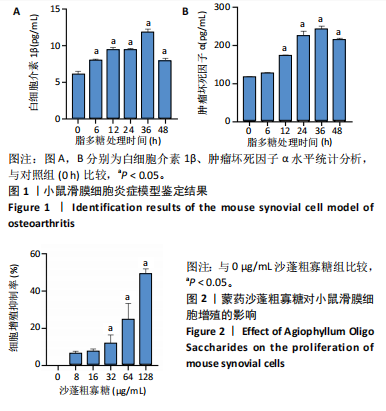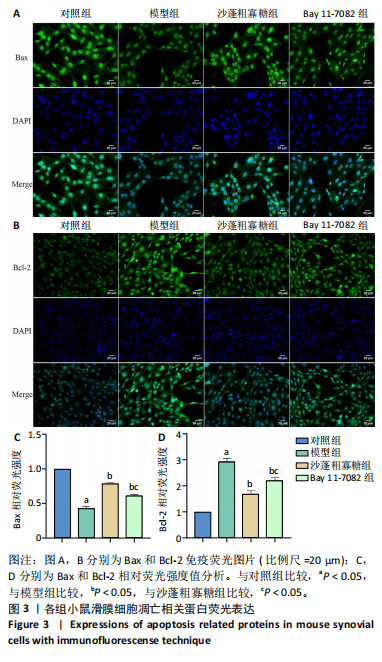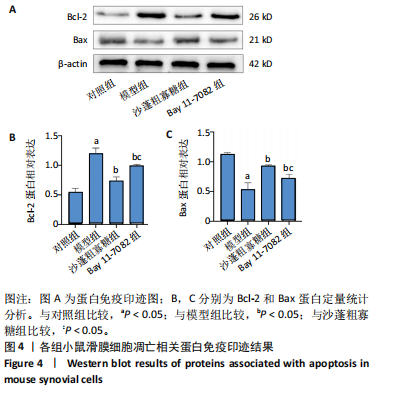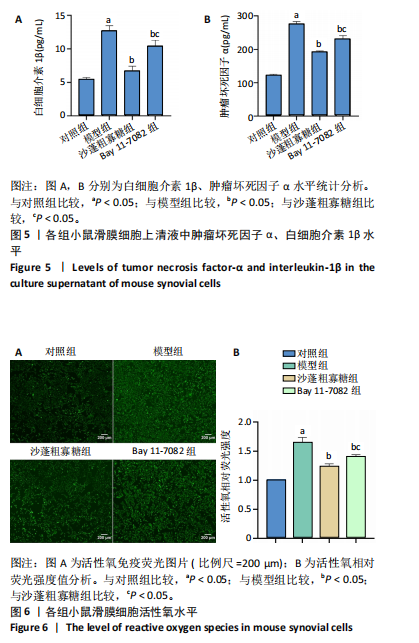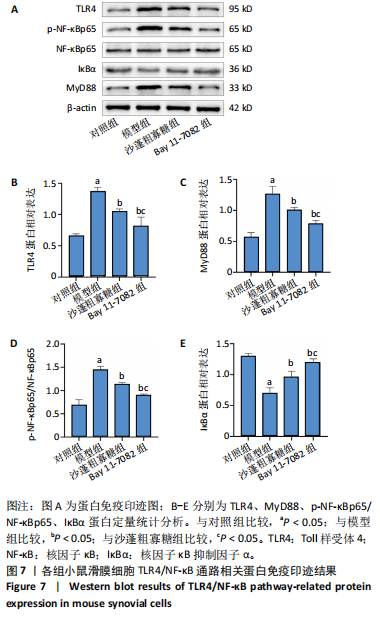[1] LOESER RF, COLLINS JA, DIEKMAN BO. Ageing and the pathogenesis of osteoarthritis. Nat Rev Rheumatol. 2016;12(7):412-420.
[2] HÜGLE T, GEURTS J. What drives osteoarthritis?-synovial versus subchondral bone pathology. Rheumatology (Oxford). 2017;56(9): 1461-1471.
[3] DAMERAU A, ROSENOW E, ALKHOURY D, et al. Fibrotic pathways and fibroblast-like synoviocyte phenotypes in osteoarthritis. Front Immunol. 2024;15:1385006.
[4] YI Y, YANG N, YANG Z, et al. LncRNA TM1-3P Regulates Proliferation, Apoptosis and Inflammation of Fibroblasts in Osteoarthritis through miR-144-3p/ONECUT2 Axis. Orthop Surg. 2022;14(11):3078-3091.
[5] DING Y, WANG L, ZHAO Q, et al. MicroRNA‑93 inhibits chondrocyte apoptosis and inflammation in osteoarthritis by targeting the TLR4/NF‑κB signaling pathway. Int J Mol Med. 2019;43(2):779-790.
[6] LI Z, ZOU Y, FAN D, et al. The mechanism of medial collateral ligament repair in knee osteoarthritis based on the TLR4/MyD88/NF-κB inflammatory signaling pathway. J Musculoskelet Neuronal Interact. 2020;20(3):398-403.
[7] 包书茵.蒙药沙蓬粗寡糖调控糖脂代谢紊乱抑制T2DM-NAFLD发生发展的机制研究[D].延边:延边大学,2022.
[8] WU S, GUO W, CHEN L, et al. Downregulation of Gadd45β alleviates osteoarthritis by repressing lipopolysaccharide-induced fibroblast-like synoviocyte inflammation, proliferation and migration. Int Immunopharmacol. 2024;126:111202.
[9] CHELESCHI S, GALLO I, BARBARINO M, et al. MicroRNA Mediate Visfatin and Resistin Induction of Oxidative Stress in Human Osteoarthritic Synovial Fibroblasts Via NF-κB Pathway. Int J Mol Sci. 2019;20(20):5200.
[10] ZHU W, JIANG C, XU J, et al. Pristane primed rat T cells enhance TLR3 expression of fibroblast-like synoviocytes via TNF-α initiated p38 MAPK and NF-κB pathways. Clin Immunol. 2015;156(2):141-153.
[11] YIN S, WANG P, XING R, et al. Transient Receptor Potential Ankyrin 1 (TRPA1) Mediates Lipopolysaccharide (LPS)-Induced Inflammatory Responses in Primary Human Osteoarthritic Fibroblast-Like Synoviocytes. Inflammation. 2018;41(2):700-709.
[12] YAO Q, WU X, TAO C, et al. Osteoarthritis: pathogenic signaling pathways and therapeutic targets. Signal Transduct Target Ther. 2023; 8(1):56.
[13] DU X, LIU ZY, TAO XX, et al. Research Progress on the Pathogenesis of Knee Osteoarthritis. Orthop Surg. 2023;15(9):2213-2224.
[14] GENG R, LI J, YU C, et al. Knee osteoarthritis: Current status and research progress in treatment (Review). Exp Ther Med. 2023;26(4): 481.
[15] GOLDRING MB, OTERO M. Inflammation in osteoarthritis. Curr Opin Rheumatol. 2011;23(5):471-478.
[16] PELLETIER JP, MARTEL-PELLETIER J, ABRAMSON SB. Osteoarthritis, an inflammatory disease: potential implication for the selection of new therapeutic targets. Arthritis Rheum. 2001;44(6):1237-1247.
[17] SMITH MD, TRIANTAFILLOU S, PARKER A, et al. Synovial membrane inflammation and cytokine production in patients with early osteoarthritis. J Rheumatol. 1997;24(2):365-371.
[18] LUO H, LI L, HAN S, et al. The role of monocyte/macrophage chemokines in pathogenesis of osteoarthritis: A review. Int J Immunogenet. 2024;51(3):130-142.
[19] ZHU R, FANG H, WANG J, et al. Inflammation as a therapeutic target for osteoarthritis: A literature review of clinical trials. Clin Rheumatol. 2024;43(8):2417-2433.
[20] CAO P, LI Y, TANG Y, et al. Pharmacotherapy for knee osteoarthritis: current and emerging therapies. Expert Opin Pharmacother. 2020; 21(7):797-809.
[21] XU HY, ZHENG HC, ZHANG HW, et al. Comparison of Antioxidant Constituents of Agriophyllum squarrosum Seed with Conventional Crop Seeds. J Food Sci. 2018;83(7):1823-1831.
[22] 冯德培.简明生物学词典[M].上海:上海辞书出版社,1983:673.
[23] 国家中医药管理局《中华本草》编写委员会.中华本草.蒙药卷[M].上海:上海科学技术出版社,2004:236-246.
[24] 朱亚民.内蒙古植物药志(第一卷) [M].呼和浩特:内蒙古人民出版社,2000:229.
[25] 包书茵,韩淑英,澈力格尔,等.沙蓬粗寡糖对GK大鼠胰岛素抵抗的影响[J].中国药理学通报,2016,32(3):403-409.
[26] 包书茵,韩淑英,朝日雅,等.沙蓬粗寡糖对GK大鼠肝、肾保护作用及机制探讨[J].中国药理学通报,2018,34(1):147-148.
[27] SCANZELLO CR, GOLDRING SR. The role of synovitis in osteoarthritis pathogenesis. Bone. 2012;51(2):249-257.
[28] CHEN H, CHEN F, HU F, et al. MicroRNA-224-5p nanoparticles balance homeostasis via inhibiting cartilage degeneration and synovial inflammation for synergistic alleviation of osteoarthritis. Acta Biomater. 2023;167:401-415.
[29] 胡善明,王亚楠,许正茂,等.Bcl-2家族分子在细胞凋亡中的作用研究进展[J].动物医学进展,2021,42(10):85-89.
[30] LOU C, LIN C, WANG W, et al. Extracts of Oldenlandia diffusa protects chondrocytes via inhibiting apoptosis and associated inflammatory response in osteoarthritis. J Ethnopharmacol. 2023;316:116744.
[31] 邢丹丹,康文越,王志华,等.右美托咪定通过抑制TLR4/NF-κB信号通路促进佐剂性膝骨关节炎大鼠成纤维细胞样滑膜细胞凋亡[J].中国病理生理杂志,2021,37(8):1479-1486.
[32] WERRY F, MAZUR E, THEYSE LFH, et al. Apoptosis Regulation in Osteoarthritis and the Influence of Lipid Interactions. Int J Mol Sci. 2023;24(17):13028.
[33] ERTEN F, OZDEMIR O, TOKMAK M, et al. Novel formulations ameliorate osteoarthritis in rats by inhibiting inflammation and oxidative stress. Food Sci Nutr. 2024;12(10):7896-7912.
[34] KAPOOR M, MARTEL-PELLETIER J, LAJEUNESSE D, et al. Role of proinflammatory cytokines in the pathophysiology of osteoarthritis. Nat Rev Rheumatol. 2011;7(1):33-42.
[35] 张梓宁,邓荣辉,付江楠,等.骨关节炎氧化应激及其干预措施的研究进展[J].中国矫形外科杂志,2023,31(15):1401-1405.
[36] AN Y, ZHANG H, WANG C, et al. Activation of ROS/MAPKs/NF-κB/NLRP3 and inhibition of efferocytosis in osteoclast-mediated diabetic osteoporosis. FASEB J. 2019;33(11):12515-12527.
[37] 陈晨,郑润泉,张贵春.大黄素对骨关节炎软骨细胞增殖、凋亡和氧化应激的影响[J].中国组织工程研究,2024,28(28):4528-4534.
[38] GUO Z, LIN J, SUN K, et al. Deferoxamine Alleviates Osteoarthritis by Inhibiting Chondrocyte Ferroptosis and Activating the Nrf2 Pathway. Front Pharmacol. 2022;13:791376.
[39] MARIANO A, BIGIONI I, MISITI F, et al. The Nutraceuticals as Modern Key to Achieve Erythrocyte Oxidative Stress Fighting in Osteoarthritis. Curr Issues Mol Biol. 2022;44(8):3481-3495.
[40] CAI D, YANG Z, ZHONG C, et al. miR-515-5p targeting Toll-like receptor 4 regulates myeloid differentiation primary response gene 88/nuclear factor-kappa B pathway to inhibit apoptosis and inflammatory response of osteoarthritis chondrocytes. Zhongguo Xiu Fu Chong Jian Wai Ke Za Zhi. 2024;38(3):315-323.
[41] KHOMEIJANI-FARAHANI M, KARAMI J, FARHADI E, et al. TAK-242 (Resatorvid) inhibits proinflammatory cytokine production through the inhibition of NF-κB signaling pathway in fibroblast-like synoviocytes in osteoarthritis patients. Adv Rheumatol. 2024;64(1):46.
[42] QI X, CHEN X, AN WB, et al. Ligusticum cycloprolactam inhibits IL-1β-induced apoptosis and inflammation of rat chondrocytes via HMGB1/TLR4/NF-κB signaling pathway. Zhongguo Zhong Yao Za Zhi. 2024;49(4):1007-1016. |
